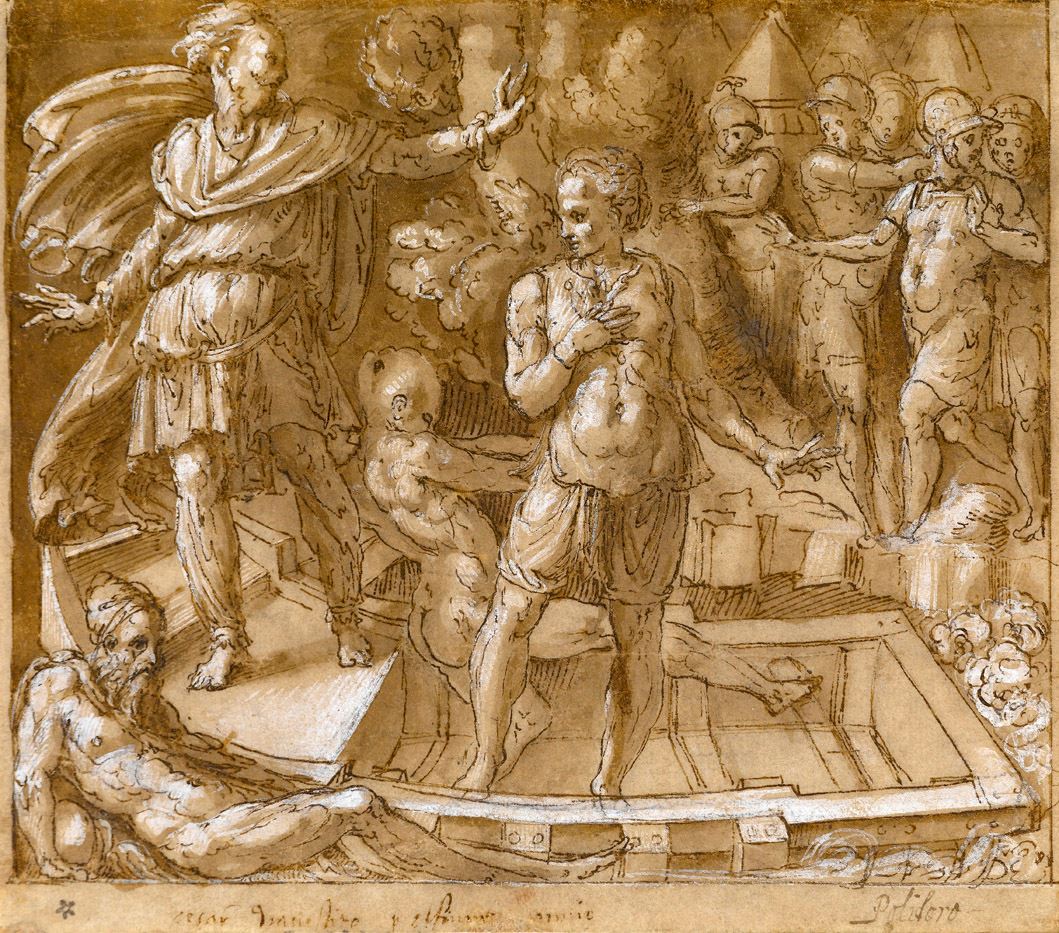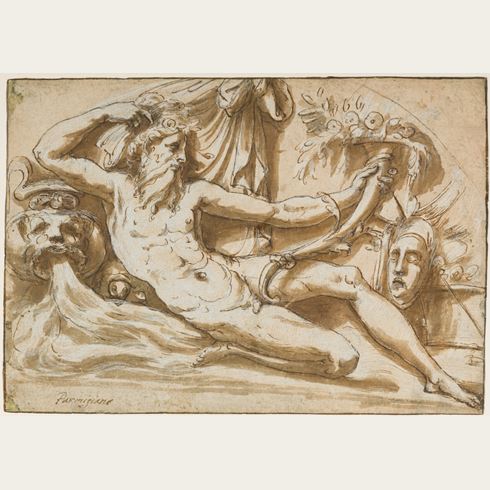Piero Buonacorsi, PERINO DEL VAGA
(Florence 1501 - Rome 1547)
Caesar on the River Aoös
Pen and brown ink and brown wash, extensively heightened with white, over traces of an underdrawing in black chalk.
Inscribed Cesar Ini…[M]iro il fiume…I aniene(?) in the lower margin and, in a different hand (Lanier?), Polidoro in the lower right margin.
137 x 152 mm. (5 3/8 x 6 in.)
Inscribed Cesar Ini…[M]iro il fiume…I aniene(?) in the lower margin and, in a different hand (Lanier?), Polidoro in the lower right margin.
137 x 152 mm. (5 3/8 x 6 in.)
This small drawing was first attributed to Perino del Vaga by Paul Joannides in 2000, and published by him four years later. The drawing, which would appear to depict a scene from Roman history, is unconnected to any surviving painting or fresco by the artist. Although Joannides had identified the subject of this drawing as Caesar Crossing the Rubicon, Dominique Cordellier has recently recognized that the composition in fact depicts Caesar on the River Aoös, another episode from the Civil War. The river Aoös (also called the Anius or Aoüs), which flows through Greece and Albania, is here personified by a river god reclining at the lower left of the composition.
A closely related drawing appears on the recto of a double-sided sheet of small compositional sketches and figure studies by Perino del Vaga formerly in the Reynolds, Calando and Lebel collections and today in the collection of Georges Pébereau in Paris. The lower sketch on the recto of the Pébereau sheet is clearly preparatory for the composition of the drawing here under discussion, and the two are very similar in size and scale, with the sketch on the former measuring approximately 136 x 182 mm. The present sheet must have been worked up from the preliminary sketch on the Pébereau drawing, although there may have been other, intervening studies. While the sketch of Caesar on the River Aoös on the Pébereau drawing shows Perino at his lightest and most fluent, the present sheet is a carefully worked-up modello, with strong and decisive line-work. The differences in the composition of this drawing and that in the Pébereau collection mainly involve the placement of the figures, notably the oarsman and the master of the boat, while the empty stern of the boat in the later drawing serves as a visual platform for the gestures of Caesar’s astonished soldiers. The forms are carefully modelled with white heightening, delicately and precisely applied with the tip of the brush, which serves to emphasize the relief nature of the composition. The overall effect is inspired by Roman sarcophagus reliefs, and it would seem likely that this drawing was intended for a relief-like composition, probably in grisaille.
While the dating of the present sheet is difficult to establish with any precision – not unusual in the work of an artist whose graphic chronology remains notoriously unstable – it would seem to have been made fairly early in Perino’s career. Joannides has suggested that the present sheet was drawn before Perino’s move to Genoa in 1527. The closest analogies in style and technique are with such drawings of the early 1520s by Perino as the Scene of Pillage in the Devonshire collection at Chatsworth and the Martyrdom of the Ten Thousand in the Albertina, in which the application of heightening in white bodycolour is closely comparable. This visual sophistication evident in the design of this drawing of Caesar on the River Aoös, and the related sketches of Caesarian narratives on the Pébereau sheet of studies, would suggest that the unknown project for which they were preparatory was the result of a commission from a patron of refined taste and knowledge, perhaps someone at the papal court in Rome. Such a frieze of scenes from the life of Caesar can well be imagined as an apt decorative scheme for the façade or interior of a Roman palace.
A closely related drawing appears on the recto of a double-sided sheet of small compositional sketches and figure studies by Perino del Vaga formerly in the Reynolds, Calando and Lebel collections and today in the collection of Georges Pébereau in Paris. The lower sketch on the recto of the Pébereau sheet is clearly preparatory for the composition of the drawing here under discussion, and the two are very similar in size and scale, with the sketch on the former measuring approximately 136 x 182 mm. The present sheet must have been worked up from the preliminary sketch on the Pébereau drawing, although there may have been other, intervening studies. While the sketch of Caesar on the River Aoös on the Pébereau drawing shows Perino at his lightest and most fluent, the present sheet is a carefully worked-up modello, with strong and decisive line-work. The differences in the composition of this drawing and that in the Pébereau collection mainly involve the placement of the figures, notably the oarsman and the master of the boat, while the empty stern of the boat in the later drawing serves as a visual platform for the gestures of Caesar’s astonished soldiers. The forms are carefully modelled with white heightening, delicately and precisely applied with the tip of the brush, which serves to emphasize the relief nature of the composition. The overall effect is inspired by Roman sarcophagus reliefs, and it would seem likely that this drawing was intended for a relief-like composition, probably in grisaille.
While the dating of the present sheet is difficult to establish with any precision – not unusual in the work of an artist whose graphic chronology remains notoriously unstable – it would seem to have been made fairly early in Perino’s career. Joannides has suggested that the present sheet was drawn before Perino’s move to Genoa in 1527. The closest analogies in style and technique are with such drawings of the early 1520s by Perino as the Scene of Pillage in the Devonshire collection at Chatsworth and the Martyrdom of the Ten Thousand in the Albertina, in which the application of heightening in white bodycolour is closely comparable. This visual sophistication evident in the design of this drawing of Caesar on the River Aoös, and the related sketches of Caesarian narratives on the Pébereau sheet of studies, would suggest that the unknown project for which they were preparatory was the result of a commission from a patron of refined taste and knowledge, perhaps someone at the papal court in Rome. Such a frieze of scenes from the life of Caesar can well be imagined as an apt decorative scheme for the façade or interior of a Roman palace.
Perino del Vaga’s career can be divided into three main periods, each lasting about nine or ten years: his training and early independent career in Rome until the sack of the city in 1527, followed by a period spent in Genoa at the court of Andrea Doria between 1528 and 1537, and a final stay in Rome - working mainly for Pope Paul III - from around 1538 until his death in 1547. He began his career as an assistant to Raphael on the decoration of the Vatican logge in 1518, and with Giovanni da Udine he decorated the Sala dei Pontefici in the Vatican in 1521. In 1522 he was working in Florence, but had returned to Rome by 1524, when he worked on the fresco decoration of the Cappella Pucci in the church of the Trinità dei Monti, as well as a cycle of frescoes for the Palazzo Baldassini and paintings for San Marcello al Corso and Santa Maria sopra Minerva.
Following the Sack of Rome in 1527 Perino settled in Genoa, where he was employed by Prince Andrea Doria on the extensive decoration of the Palazzo Doria on the outskirts of the city - a project which occupied the artist for several years - and also received several commissions for religious and secular paintings. Although Perino stayed less than ten years in Genoa, his influence on the local school of painters was significant. He is also documented in Pisa in 1534, working in the Duomo. Perino returned in the late 1530’s to Rome, where he gained the patronage of the Farnese Pope Paul III. Perino worked extensively on the decoration of the various rooms of the Castel Sant’Angelo and the Sala Regia of the Vatican.
Characterized by considerable inventiveness, range and skill, Perino del Vaga’s drawings mark him as one of the most gifted draughtsmen of the 16th century in Italy. Giorgio Vasari rated him very highly (‘the best and most finished draughtsman that there was among all who were drawing in Rome’), and noted that he drew constantly. His drawings range from sheets of rapid sketches to elaborate and highly finished figure and composition studies. The majority of Perino’s surviving drawings are studies in pen and ink; a medium the artist seems to have preferred by virtue of its fluidity and expressiveness. His drawings often serve as the only record of large-scale damaged or destroyed commissions, and relatively few examples can be related to surviving works. Vasari notes that ‘Perino left many designs at his death, some by his hand and some by others…All these designs, with other things, were sold by his heirs; and in our book are many drawings done by him with the pen, which are very beautiful.’ Many of Perino’s drawings were sold by his daughter after his death to the art dealer Jacopo Strada in 1556. These included copies after other artists and, according to another contemporary writer, drawings of an ‘endless number of funerary reliefs, statues, and grotesques copied from classical works.’
Provenance
Nicholas Lanier, London (Lugt 2886)
Probably John Evelyn, Deptford and London
By descent to J. H. C. Evelyn and Major Peter Evelyn
Their posthumous sale, London, Christie’s, 6 July 1977, part of lot 1 (as Circle of Perino del Vaga)
Private collection, England
Anonymous sale, New York, Christie’s, 28 January 1999
Anonymous sale, London, Phillips, 13 December 2000, lot 121 (as attributed to Pirro Ligorio)
Mia Weiner, New York
Private collection, Madrid.
Probably John Evelyn, Deptford and London
By descent to J. H. C. Evelyn and Major Peter Evelyn
Their posthumous sale, London, Christie’s, 6 July 1977, part of lot 1 (as Circle of Perino del Vaga)
Private collection, England
Anonymous sale, New York, Christie’s, 28 January 1999
Anonymous sale, London, Phillips, 13 December 2000, lot 121 (as attributed to Pirro Ligorio)
Mia Weiner, New York
Private collection, Madrid.
Literature
Paul Joannides, ‘Some New Drawings by Perino del Vaga’, in Elena Parma, ed., Perino del Vaga: prima, durante, dopo. Atti delle Giornate Internazionali di Studio, Genova 26-27 maggio 2001, Palazzo Doria “del Principe”, Genoa, 2004, pp.18-19, fig.7; Elena Parma, ‘Introduzione’, in Parma, ed., ibid., p.8; Dominique Cordellier, Louis-Antoine Prat and Carel van Tuyll van Serooskerken, ed., Maîtres du dessin européen du XVIe au xxe siècle: La collection Georges Pébereau, exhibition catalogue, Paris, Musée du Louvre, 2009-2010, p.20, fig.1, under no.2 (entry by Dominique Cordellier).






